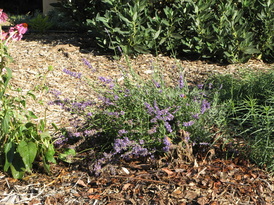Notes From the Garden
The San Gabriel Chapter of the California Native Plant Society hosted Dr. Stephen Davis, plant ecologist from Pepperdine University, at its May meeting. Dr. Davis presented a talk on the extended drought and its effects on California chaparral. His research involved two “bookend” species essential to the healthy functioning of the chaparral ecosystem: Laurel Sumac and Bigpod Ceanothus. These plants were chosen as the two plants with the most hearty comeback potential after fire. Laurel Sumac has incredibly deep roots that persist after fire, allowing the plant to send up suckers after the main trunk has been burned. Bigpod Ceanothus seeds break open during fire, so seeds can germinate post fire.
Both are survivor species. Laurel Sumac may have roots as deep as 42’, allowing the plant to tap in to deep water resources. Bigpod Ceanothus Has great capacity for withstanding dehydration during drought times. Both have survivied for thousands of years.
But now we face the special challenges of climate change. Most droughts in California since the Pleistocene endured for 20 years or less. Occasionally droughts of 30-100 years were recorded. During these times normal air temperatures prevailed. Currently we are experiencing the mean temperature creepin, and in some cases, leaping in ways we have never experienced. Coupled with the lack of rainfall, Dr. Davis and his students have noticed a dramatic shift in the response of the bookend species.
Laurel Sumac has been attacked throughout the Malibu area by a fungus that usually lives commensurately with the plant. This is causing cankers to form throughout the plant that thwart the rise of water from roots to stems, thus stressing the plant and ultimately killing it.
Bigpod Ceanothus has relatively shallow roots (+-5’). During drought it dessicates readily, sending its energy into the main stem of the plant. If it dessicates too far it has the effect of splitting the bark, allowing air into flow passages, essentially creating a plant embolism. The plant dies back, unable to deliver fluid to all its parts. Also the seeds have been germinating not from hot fire followed by rain, but by increased soil temperature followed by hot, dry weather. In the current situation the seed sprouts only to be dried out and killed.
Dr. Davis and his students are documenting a phenomenon never witnessed before. Their area of study is an area in Malibu that burns every 7 years or so. Nonetheless he concludes that our chaparral landscape is in big trouble from climate change and extended drought.
For more information:
http://seaver-faculty.pepperdine.edu/davis/
— January Nordman
Photo by Therese Brummel.
Both are survivor species. Laurel Sumac may have roots as deep as 42’, allowing the plant to tap in to deep water resources. Bigpod Ceanothus Has great capacity for withstanding dehydration during drought times. Both have survivied for thousands of years.
But now we face the special challenges of climate change. Most droughts in California since the Pleistocene endured for 20 years or less. Occasionally droughts of 30-100 years were recorded. During these times normal air temperatures prevailed. Currently we are experiencing the mean temperature creepin, and in some cases, leaping in ways we have never experienced. Coupled with the lack of rainfall, Dr. Davis and his students have noticed a dramatic shift in the response of the bookend species.
Laurel Sumac has been attacked throughout the Malibu area by a fungus that usually lives commensurately with the plant. This is causing cankers to form throughout the plant that thwart the rise of water from roots to stems, thus stressing the plant and ultimately killing it.
Bigpod Ceanothus has relatively shallow roots (+-5’). During drought it dessicates readily, sending its energy into the main stem of the plant. If it dessicates too far it has the effect of splitting the bark, allowing air into flow passages, essentially creating a plant embolism. The plant dies back, unable to deliver fluid to all its parts. Also the seeds have been germinating not from hot fire followed by rain, but by increased soil temperature followed by hot, dry weather. In the current situation the seed sprouts only to be dried out and killed.
Dr. Davis and his students are documenting a phenomenon never witnessed before. Their area of study is an area in Malibu that burns every 7 years or so. Nonetheless he concludes that our chaparral landscape is in big trouble from climate change and extended drought.
For more information:
http://seaver-faculty.pepperdine.edu/davis/
— January Nordman
Photo by Therese Brummel.





